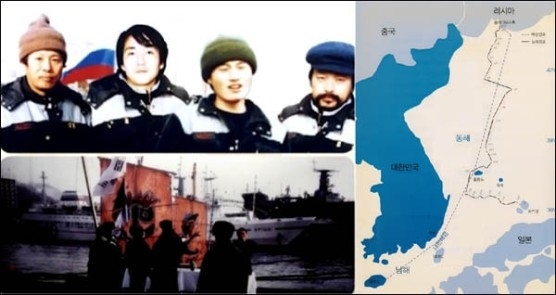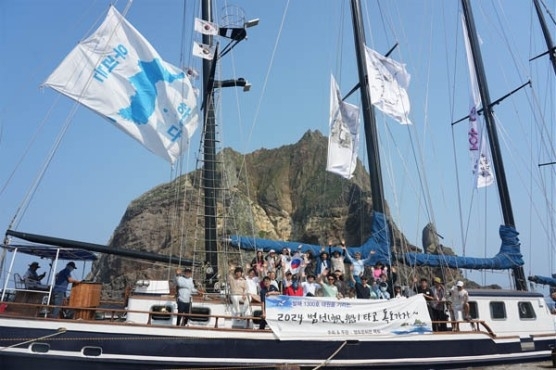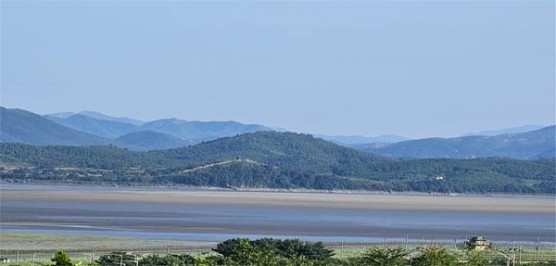
Community
Share various information for members to communicate
The Balhae 1300 expedition team and their raft at Vladivostok Port on December 30, 1997. (Left: The team and the raft. Right: The planned voyage route.) [Photo provided by Ahn Jae-young]
A Voyage of Discovery: The Balhae 1300 Expedition
Constructed from ash wood, the 15-meter raft carried a crew of four: Captain Jang Cheol-su (38), navigator Lee Deok-young (49), photographer Lee Yong-ho (35), and communications officer Im Hyun-gyu (27). Their audacious journey to recreate the ancient maritime route of Balhae was driven by a deep-seated passion for Korea's maritime heritage.
Captain Jang, a man often described as "obsessed with the sea," had long been an advocate for protecting Korea's maritime territories, particularly Dokdo Island. His belief in the importance of the ocean was evident in his words: "The 21st century will be an era of the ocean. The struggle over maritime territorial divisions began long ago. The Dokdo issue is not just about land; it's about the sea. Losing Dokdo means losing a vast expanse of our maritime territory."
When the expedition set sail on December 31, 1997, Captain Jang declared, "What we have done until now, anyone could have done. But what we are about to do, no one else can. We will surely succeed. What we truly seek is the courage to forgive the unforgivable and the courage to pioneer a new beginning. This is the true meaning of the Balhae 1300."
The raft encountered severe storms on several occasions. Unable to withstand the immense force of nature, the Balhae 1300 was driven far off course and ultimately crashed into the Oki Islands of Japan on the 24th day of the voyage, claiming the lives of all four crew members.
The crew members, each with their own unique backgrounds and motivations, shared a common belief in the importance of preserving Korea's maritime heritage. Their tragic loss serves as a poignant reminder of their dedication and the risks they took in pursuit of their dreams.

The sailboat Koreana and Seodo Island, captured on June 19, 2024. [Photo by Ahn Jae-young]
The Korea Maritime Museum, under the direction of Ahn Jae-young, organized a voyage aboard the sailboat Koreana, captained by Jeong Chae-ho. With the aim of fostering the spirit of challenge and maritime adventure exhibited by the crew of the Balhae 1300 expedition, 31 explorers and 6 crew members set sail from Hupo Port on June 18, 2024.
After sailing tirelessly for 14 hours, the Koreana arrived at Dokdo Island at 7 AM on June 19. To meet the 8 AM entry time set by the Ulleung County government, the Koreana circled Dokdo slowly. During this time, Dong-a Jido's representative, Ahn Dong-rip, provided a detailed explanation of Dokdo's unique features and place names.
Dokdo holds a peculiar significance for the South Korean people. Regardless of the hardships endured to reach it, the sight of Dokdo evokes a surge of patriotism, erasing all memories of hardship.
While Dokdo is merely one of the over 3,000 islands belonging to South Korea, its value extends far beyond that of a simple island. Since the United Nations Convention on the Law of the Sea came into effect in 1994, the concept of a "maritime territory" has been established.
Article 121, paragraph 1, of the Convention defines an island as a naturally formed area of land that is surrounded by water and that is above water at high tide. Paragraph 3 stipulates that only islands that can sustain human habitation are considered islands and are entitled to an exclusive economic zone (EEZ) of 200 nautical miles.
Conversely, artificially created features or those that cannot sustain human habitation (lacking water or vegetation) are defined as rocks, regardless of size, and are not entitled to an EEZ or continental shelf.
Dokdo has a water source that produces over 400 liters of water per day and supports vegetation, fulfilling the basic conditions for human habitation. Thus, it undoubtedly qualifies as an island. However, due to Japan's objections and South Korea's relatively weaker international standing, Dokdo has not been officially recognized as an island, preventing South Korea from claiming an EEZ around it.
Despite the failure of the North America-Vietnam summit in February 2019, a North America-South Korea summit and inter-Korean summit were held on June 30 of the same year. However, these meetings were insufficient to overcome the deep-rooted mistrust between North and South Korea that had accumulated since the armistice.
In December 2022, North Korean leader Kim Jong-un defined inter-Korean relations as being "between two states at war," indicating the possibility of armed conflict at any time.
In May 2024, the Free North Korea Movement, led by Park Sang-hak, claimed to have sent 300,000 leaflets and 2,000 USB drives containing videos to North Korea. In response, North Korea launched a series of balloon attacks on South Korea from May 28 to June 26.
Since the armistice, North Korea has not installed proper fences along the Northern Limit Line, with only the Military Demarcation Line (MDL) being visible. However, following the exchange of leaflets between the two Koreas, North Korea has begun installing fences in some sections along the armistice line. While some South Korean media initially reported that North Korea was building a Berlin Wall-like structure, the prevailing opinion now is that these fences are symbolic, signifying a separation between the two Koreas.
I concur with this interpretation of the fences as a symbolic separation. The flimsy nature of the fences suggests that they are not intended to be defensive barriers.

section of the newly installed barbed wire fence in Gaepo County, North Korea, near the Imjin River estuary, as of July 15, 2024. [Photo provided by Ahn Jae-young]
The prospect of improving inter-Korean relations at the government level seems bleak, regardless of changes in South Korea's political leadership. It is likely that significant progress will be hindered until the North Korean regime successfully achieves self-reliance.
This assessment is based on an analysis of North Korea's New Year's stamps. While the 2020 stamps depicted a pine tree heavily laden with snow (symbolizing difficult circumstances) and a group of people riding a Chollima (a mythical horse symbolizing rapid progress) above a science and technology building, subsequent years have consistently featured themes of urban development and construction. This shift in imagery suggests a growing focus on domestic economic development.
Given North Korea's strategy of prioritizing economic development through engagement with traditional friendly nations while neglecting relations with the South, it is imperative for South Korean civil society to continue to seek avenues for engagement.
North Korea has issued stamps related to Dokdo Island on three occasions (2004, 2005, and 2014). They have also published a historical novel titled "Dokdo Guardian Ahn Yong-bok," which romanticizes the life of the late Joseon Dynasty fisherman who defended Dokdo. Dokdo is a precious treasure shared by both South and North Korea, and Ahn Yong-bok is a common hero for both nations in their defense of Dokdo. Given the current state of inter-governmental relations, now is the time for South and North Korea to engage in civil society exchanges centered around Dokdo.
Source from http://www.tongilnews.com
| 댓글 0 개 |
| 번호 | 제목 | 작성자 | 등록일 |
|
|
|
|
|
|





